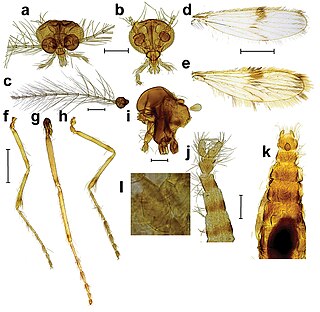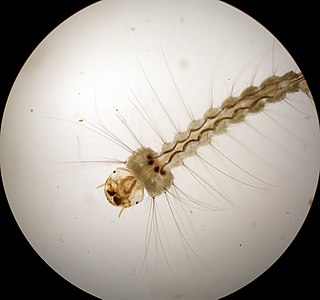Related Research Articles

Toxorhynchites, also called elephant mosquito or mosquito eater, is a genus of diurnal and often relatively colorful mosquitoes, found worldwide between about 35° north and 35° south. Most species occur in forests. It includes the largest known species of mosquito, at up to 18 mm (0.71 in) in length and 24 mm (0.94 in) in wingspan. It is among the many kinds of mosquito that do not consume blood. The adults subsist on carbohydrate-rich materials, such as honeydew, or saps and juices from damaged plants, refuse, fruit, and nectar.

A glassworm is a type of larva of a midge genus called Chaoborus. They are also known as phantom midge larvae, because they are transparent. They can be found commonly in lakes all over the world and can be up to 2 cm (0.8 in). The adults are sometimes called phantom midges or lake flies.
The Mayor of Johannesburg is the chief executive of the City Council and the highest elected position in the city of Johannesburg, South Africa.
Haemagogus is a genus of mosquitoes in the dipteran family Culicidae. They mainly occur in Central America and northern South America, although some species inhabit forested areas of Brazil, and range as far as northern Argentina. In the Rio Grande Do Sul area of Brazil, one species, H. leucocelaenus, has been found carrying yellow fever virus. Several species have a distinct metallic sheen.

Corethrella is a genus of midges that are classified in the family Corethrellidae.

Anopheles is a genus of mosquitoes (Culicidae). Of about 484 recognised species, over 100 can transmit human malaria, but only 30–40 commonly transmit parasites of the genus Plasmodium that cause malaria, which affects humans in endemic areas. Anopheles gambiae is one of the best known, because of its predominant role in the transmission of the deadly species Plasmodium falciparum.

Cuterebra, or rodent bots, is a genus of flies that attack rodents and similar animals.
Mansonia mosquitoes are big, black or brown mosquitoes with sparkling on their wings and legs. They breed in ponds and lakes containing certain aquatic plants, especially the floating type like Pistia stratiotes and water hyacinth. The eggs are laid in star-shaped clusters on the undersurface of leaves of these plants. The larvae and pupae are found attached to the rootlets of these plants by their siphon tubes. They obtain their air supply from these rootlets. When about to become adult, these pupae come to the surface of water and the fully formed adults emerge and escape. The control of Mansonia mosquitoes is easy by removal or destruction of the aquatic host plants by herbicides.
Uranotaenia is a subgenus of the mosquito genus Uranotaenia with 121 species:
Sabethes mosquitoes are primarily an arboreal genus, breeding in plant cavities. The type species is Sabethes locuples, first described by Jean-Baptiste Robineau-Desvoidy in 1827.

Wyeomyia is a genus of mosquitoes first described in 1901 by Frederick Vincent Theobald. The genus's 140 species can be difficult to characterize because of their diversity and the need for additional taxonomic work to further delineate them. Adults resemble genus Limatus and Sabethes mosquitoes more closely than other genera in the New World tribe Sabethini, but differ by their scutal scales ranging in color from a relatively dull bronzy with a slight metallic sheen in most species, to a metallic gold. There are other distinguishing characters as well.
Orthopodomyia is a genus of mosquitoes in the family Culicidae. There are at least 40 described species in Orthopodomyia.
Deinocerites is a genus of mosquitoes in the family Culicidae. There are about 18 described species in Deinocerites.
References
- 1 2 "Wyeomyia Report". Integrated Taxonomic Information System. Retrieved 2018-05-06.
- 1 2 "Browse Wyeomyia". Catalogue of Life. Retrieved 2018-05-06.
- 1 2 "Wyeomyia". GBIF. Retrieved 2018-05-06.
- 1 2 "Wyeomyia Genus Information". BugGuide.net. Retrieved 2018-05-06.